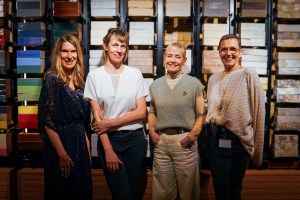Snøhetta was founded on the United Nations' 1987 Brundtland Commission’s three main pillars of sustainable development: economic growth, environmental protection, and social equality. Their highly valued and purpose-driven operations have since then expanded to 330 employees in 7 studios all over the world, from hometown Oslo to Adelaide, Hong Kong, Paris and Innsbrück, as well as their sister studios in New York and San Fransisco.
Sustainable development is still a fundamental part of how they run their company and collaborate with partners and clients across the world. And it’s a fundamental part of how they ensure their position continues to connect to the humanistic and value-driven foundation of their business. Consequently, anyone they work with will experience that a collaboration with Snøhetta is a different kind of collaboration. With a more than 30-year-old history of using bold architecture and design to drive positive change, two elements remain at the core: Creating human connection and collective ownership as well as driving social and environmental enhancements.

Social responsibility, integrity, and ethics are at the core of Snøhetta’s business and behaviour as individuals, as a collective, and as a company. Their ambition is set on delivering unique contextual relevant projects that make the world a better place by:
- increasing social equality
- fostering accessibility to the public
- increasing social interactions
- reducing carbon emissions and promoting biodiversity
Snøhetta’s Director of Acquisition & Business Development in Europe, Jette Hopp, elaborates:
“Our core humanistic values are present in everything we do – from our design methodology to our company culture. It is an implicit part of how we run and develop our business, and hence becomes part of our market position and identity. We believe this is a core element in how we effectively differentiate ourselves in the market, through both our operations, concepts and projects, as well as strategic collaborations.”

Value-driven business development
Snøhetta’s strategy is to be world-leading in innovative architecture and design. Everything they do aims at maintaining their market-leading position and delivering customer value in line with their value proposition. From a business development perspective, a value-based approach provides a solid guide for their day-to-day operations. And it is surely not something that can be taken lightly or done merely as a theoretical exercise. At Snøhetta, this approach has been part of their core since the very beginning, and it acts like a guide for which projects they take on, in which collaborations they engage, and which topics they choose to drive and develop in the market. Example includes cutting-edge concepts for environmental sustainability through the Powerhouse projects, as well as making culture and public space available to more people through their approach in numerous principal cultural projects in different parts of the world, like the Bibliotheca Alexandrina in Egypt, the Shanghai Opera house and the Norwegian National Opera and Ballet.

Snøhetta has clear criteria for which projects and partners they engage with, also rooted in their values. And they do not shy away from difficult discussions.
In today’s world with conflict, polarized discussions and political challenges present in most parts of the world, being an architectural and design practice with a global footprint raises several complex questions on a regular basis. There are few regions they exclude completely from their portfolio, and this is based on a clear policy:
At Snøhetta, they believe architecture and design have the capacity to bring the world forward towards a better future. They also believe architecture and design have the responsibility to take on this role. Snøhetta wants to positively impact society through their work and they do not shy away from matters that might be difficult or controversial but engage with them to influence and put the world on a more sustainable path.

They do this through their emphasis on social, economic and environmental sustainability and by promoting culture. Culture transcends boundaries and political systems and increases the diversity of ideas available to people. That’s why they consider doing cultural projects in a country even though they might reject other projects in the same place. Architectural activities can have a diplomatic, foreign-policy dimension and one must hope that cooperation and dialogue make a difference.
Snohetta’s work is based on the three cornerstones of sustainability – social, economic, and environmental sustainability. Coupled with their focus on culture, they believe that projects that incorporate these elements make them part of a force that affects the present and changes the future in a positive direction.

Way of working
Since Snøhetta’s inception, they have maintained their original transdisciplinary approach, and integrated architectural, landscape, interior, product, graphic, digital design and art across their projects. The collaborative nature between Snøhetta's different disciplines is an essential driving force of the practice.
Another core element of their practice is their collective approach to conceptual thinking and their fondness for examining projects from an interdisciplinary perspective which is core to developing their portfolio and bold concepts to create positive change.
Each project is approached as unique, regardless of size or complexity. The uniqueness is not only rooted in different contextual situations but also in the prevailing socially defined conditions. Projects are regarded as social tools and thus strive to create interactive places for users and visitors.

In conclusion, Snøhetta’s working method practices a simultaneous exploration of traditional craftsmanship and cutting-edge digital technology. Snøhetta thrives on rich collaborations with partners and clients. A drive for a continuous state of reinvention is essential to their work. At the heart of all of Snøhetta’s work lies a commitment to social and environmental sustainability, shaping the built environment and design in the service of humanism. Snøhetta believes well-conceived design can help things run more efficiently, improve people’s well-being and make life more enjoyable. Every project is designed with strong, meaningful concepts in mind – concepts that can translate the ethos of its users and their context.




